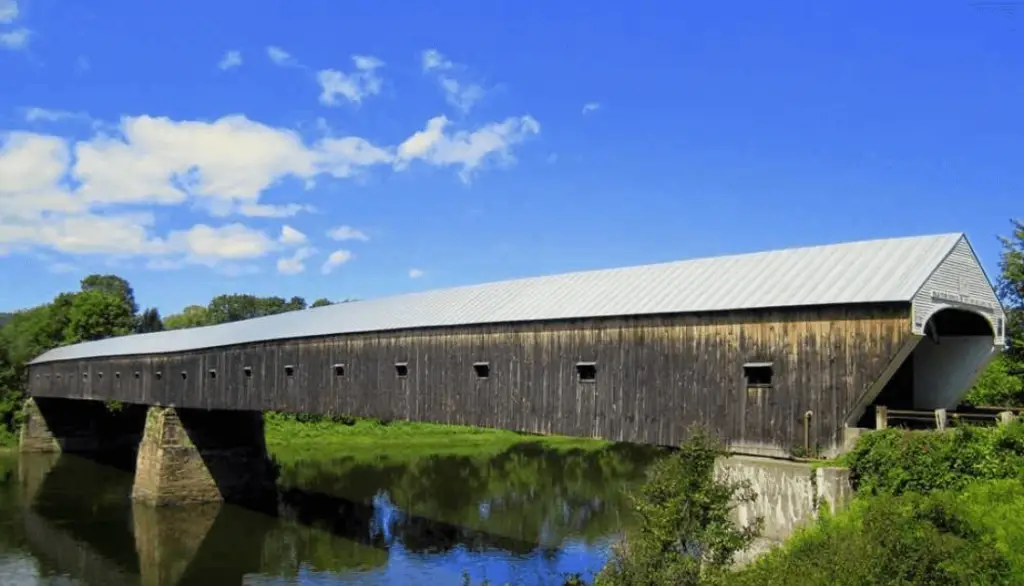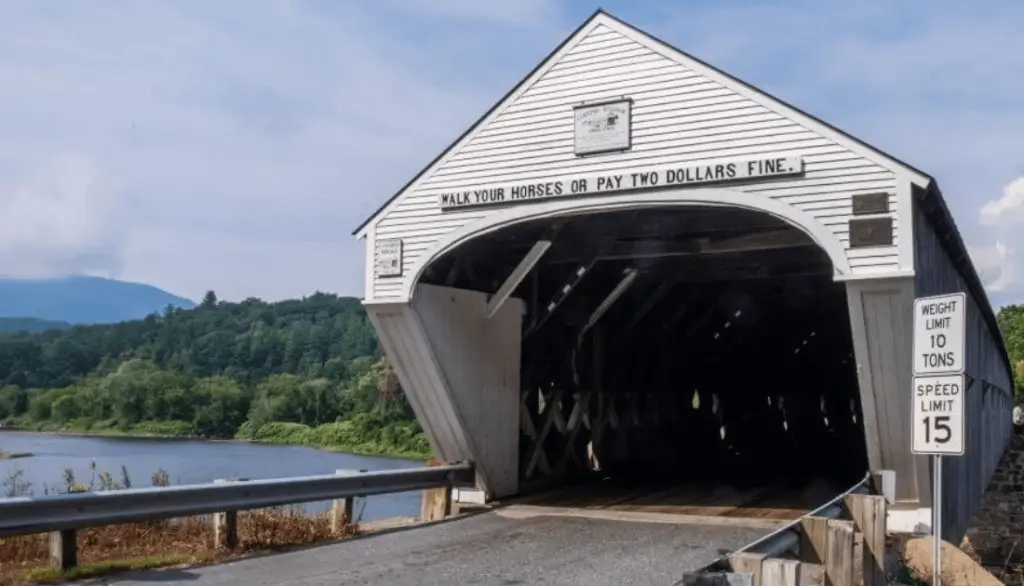Did you ever cross a bridge that felt like a journey through time? The Connecticut River Bridge is an architectural wonder that gives the charm of a bygone era. This architectural marvel was built in 1866 and joined two states.
It is full of New England charm and stands across the Connecticut River. It is known as the “kissing bridge.” Cornish-Windsor is the United States’ longest wooden covered bridge and the world’s largest two-span covered bridge.
Moreover, it is a well-known tourist destination. While visiting New Hampshire and Vermont, thousands of people visit this historic site each year to enjoy the scenic beauty of covered architectural heritage.
This architectural mastery has been a vital transportation link between New Hampshire and Vermont for many years. The local landmark is 24 feet wide and 5 inches long, and the total length is 449 feet.
Another feature of this historic landmark is that it allows vehicular traffic to cross the bridge, while other historic covered bridges only allow pedestrians to travel by foot.
Cornish-Windsor Bridge History
Evidence shows that the first bridge was built in the last decade of the 18th century and was demolished by floodwater in 1824. Bela Fletcher again constructed this bridge in 1866. There are also three other bridges at this location, built in 1796, each taller than the last.
As well as its architectural significance, the building is notable for its use of the Town lattice truss that distributes all the weight equally. Architect Ithiel Town invented the unique design.
Many other New England bridges have also been built using this type of design, but this local landmark still holds the record for being the longest covered bridge that has existed over the years.
In 1936, the state government bought this privately owned river crossing after allocating the funds to the New Hampshire General Court. The private owners used it as a toll bridge.
In 1970, the American Society of Civil Engineers acknowledged the scenic landmark’s significance and declared it a National Historic Civil Engineering Landmark.
Furthermore, this New Hampshire landmark has also been listed on the National Register of Historic Places since 1976. Since 1976, the bridge has also been shown on the Town Bicentennial Medal. Its registered number is 29-10-09 in the World Guide to Covered Bridges.

What are the Reasons to Visit New England’s Longest Covered Bridge?
Photographer’s Paradise:
The timeless beauty of this architectural mastery makes it an ideal place for amateur or professional photographers.
Historical Exploration:
This longest-covered bridge provides a delightful experience to history enthusiasts. They can explore how this building was built and what the role of the community is through interpretive signs.
Scenic Drives:
While visiting this historic place, the charming New England landscapes will make your journey more scenic. You will see quaint villages, rolling hills, and riverside vistas.
Things to Do Near the Cornish-Windsor Covered Bridge
Exploring other unique places in the Upper Connecticut Valley while in this part of Sullivan County and New England is worthwhile.
Saint-Gaudens:
Are you seeking an enjoyable location to spend a lovely afternoon? Look no further than Saint-Gaudens National Historic Site. You can tour Augustus Saint-Gaudens’ famous home or hike the trails that cross the grounds of his estate.
This tour is helpful to learn more about one of the most acclaimed sculptors in American history. There are also numerous pieces of Saint-Gaudens’ work on display at this national historic park, including his Abraham Lincoln statue. The entry fee to visit this landmark site is $10.
Cornish’s Covered Bridges:
Despite being the longest and most popular Connecticut River Bridge, this area has many other charming attractions. In Plainfield, the two old wooden bridges, Cornish’s Dingleton Hill Bridge and Blow-Me-Down Bridge, offer you a timeless pleasure.
The Blacksmith Shop Bridge is a beautiful spot for photographs and runs across Mill Brook in Cornish. The river crossing is closed for driving but safe for pedestrians. James Tasker constructed all these New Hampshire landmarks.

Hanover:
Hanover is a scenic town located in Grafton County, Nh. It is situated along the Connecticut River, which decreases the distances between New Hampshire and Vermont. This small New England town has beautiful natural scenery and many outdoor recreational opportunities.
Hanover is well-known for Ivy League school Dartmouth College. The Hood Museum of Art and Hopkins Center for the Arts, which host a variety of performances and exhibitions, are among two of the best Tourist attractions on the Dartmouth campus.
The hearty downtown area also has many restaurants, shops, and cafes, making it a nice place to stroll and explore. Outdoor enthusiasts will love Pine Park, which is full of natural beauty.
Lake Sunapee:
Lake Sunapee is an ideal choice for spending time on the beach while enjoying nature. The lake’s water is blue, surrounded by forests and mountains. You will enjoy the beach a lot at Mt. Sunapee State Park. If you visit Mt. Sunapee State Park, you will enjoy it a lot, with many beach-related activities.
Frequently Asked Questions
Q. Is the Cornish-Windsor Bridge open to pedestrians?
Yes, it is open for pedestrians and offers a historic atmosphere and beautiful views.
Q. Can I drive through the bridge?
Yes, it is open for vehicular traffic, but other historic covered bridges only allow pedestrians to cross on foot.
Q. Is there an entrance fee to visit the Cornish-Windsor Bridge?
There is no fee to visit this historic public attraction.
More from Dartmouth-Sunapee:
- 11 Best Restaurants in Hanover, NH
- 14 Fun Things To Do in Hanover, NH
- 30+ Best Lake Sunapee Rentals
